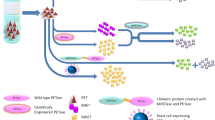Abstract
Bacteria capable of growing on poly(3-hydroxybutyrate), PHB, as the sole source of carbon and energy were isolated from various soils, lake water, activated sludge, and air. Although all bacteria utilized a wide variety of monomeric substrates for growth, most of the strains were restricted to degrade PHB and copolymers of 3-hydroxybutyrate and 3-hydroxyvalerate, P(3HB-co-3HV). Five strains were also able to decompose a homopolymer of 3-hydroxyvalerate, PHV. Poly(3-hydroxyoctanoate), PHO, was not degraded by any of the isolates. One strain, which was identified asComamonas sp., was selected, and the extracellular depolymerase of this strain was purified from the medium by ammonium sulfate precipitation and by chromatography on DEAE-Sephacel and Butyl-Sepharose 4B. The purified PHB depolymerase was not a glycoprotein. The relative molecular masses of the native enzyme and of the subunits were 45,000 or 44,000, respectively. The purified enzyme hydrolyzed PHB, P(3HB-co-3HV), and—at a very low rate—also PHV. Polyhydroxyalkanoates, PHA, with six or more carbon atoms per monomer or characteristic substrates for lipases were not hydrolyzed. In contrast to the PHB depolymerases ofPseudomonas lemoignei andAlcaligenes faecalis T1, which are sensitive toward phenylmethylsulfonyl fluoride (PMSF) and which hydrolyze PHB mainly to the dimeric and trimeric esters of 3-hydroxybutyrate, the depolymerase ofComamonas sp. was insensitive toward PMSF and hydrolyzed PHB to monomeric 3-hydroxybutyrate indicating a different mechanism of PHB hydrolysis. Furthermore, the pH optimum of the reaction catalyzed by the depolymerase ofComamonas sp. was in the alkaline range at 9.4.
Similar content being viewed by others
References
A. J. Anderson and E. A. Dawes (1990)Microbiol. Rev. 54 450–472.
G. N. Bernard and J. K. M. Sanders (1989)J. Biol. Chem. 264 3286–3291.
H. Blum, H. Beier, and H. J. Gross (1987)Electrophoresis 8 93–99.
H. Brandl, R. A. Gross, R. W. Lenz, and R. C. Fuller (1988)Appl. Environ. Microbiol. 54 1977–1982.
D. Byrom (1990) in E. A. Dawes (Ed.),Novel Biodegradable Microbial Polymers, Kluwer Academic Publishers, Dordrecht, pp. 113–117.
A. A. Chowdhury (1963)Arch. Mikrobiol. 47 167–200.
S. Coulombe, P. Schauwecker, R. H. Marchessault, and B. Hauttecoeur (1978)Macromolecules 11 279–281.
F. P. Delafield, K. E. Cooksey, and M. Doudoroff (1965)J. Biol. Chem. 240 4023–4028.
F. P. Delafield, M. Doudoroff, N. J. Palleroni, C. J. Lusty, and R. Contopoulos (1965)J. Bacteriol. 90 1455–1466.
M. J. de Smet, G. Eggink, B. Witholt, J. Kingma, and H. Wynberg (1983)J. Bacteriol. 154 870–878.
W. G. C. Forsyth, A. C. Hayward, and R. B. Roberts (1958)Nature (London) 182 800–801.
R. Griebel, Z. Smith, and J. M. Merrick (1968)Biochemistry 7 3676–3681.
H. Hippe and H. G. Schlegel (1967)Arch. Mikrobiol. 56 278–299.
P. H. Janssen and C. G. Harfoot (1990)Arch. Microbiol. 154 253–259.
U. K. Laemmli (1970)Nature (London) 227 680–685.
R. G. Lageveen, G. W. Huismann, H. Preusting, P. Ketelaar, G. Eggink, and B. Witholt (1988)Appl. Environ. Microbiol. 54 2924–2930.
C. J. Lusty and M. Doudoroff (1966)Proc. Natl. Acad. Sci. USA 56 960–965.
J. M. Merrick and M. Doudoroff (1964)J. Bacteriol. 88 60–71.
J. M. Merrick (1965)J. Bacteriol. 90 965–969.
J. M. Merrick, G. Lundgren, and R. M. Pfister (1965)J. Bacteriol. 89 234–239.
K. Nakayama, T. Saito, T. Fukui, Y. Shirakura, and K. Tomita (1985)Biochim. Biophys. Acta 827 63–72.
T. Saito, K. Suzuki, J. Yamamoto, T. Fukui, K. Miwa, K. Tomita, S. Nakanishi, S. Odani, J.-I. Suzuki, and K. Ishikawa (1989)J. Bacteriol. 171 184–189.
H. G. Schlegel, G. Gottschalk, and R. v. Bartha (1961)Nature (London) 191 463–465.
H. G. Schlegel, H. Kaltwasser, and G. Gottschalk (1961)Arch. Mikrobiol. 117 475–481.
H. G. Schlegel and G. Gottschalk (1962)Angew. Chem. 74 342–347.
J. P. Segrest and R. L. Jackson (1972)Methods Enzymol. 28 54–63.
Y. Shirakura, T. Fukui, T. Tanio, K. Nakayama, R. Matsuno, and K. Tomita (1983)Biochim. Biophys. Acta 748 331–333.
Y. Shirakura, T. Fukui, T. Saito, Y. Okamoto, T. Narikawa, K. Koide, K. Tomita, T. Takemasa, and S. Masamune (1986)Biochim. Biophys. Acta 880 46–53.
C. W. Shuster and M. Doudoroff (1962)J. Biol. Chem. 237 603–607.
H. Stegemann, H. Francksen, and V. Macko (1973)Z. Naturforsch. 28c 722–732.
A. Steinbüchel (1991)Nachr. Chem. Tech. Lab. 39 1116–1123.
A. Steinbüchel (1991) in D. Byrom (Ed.),Biomaterials, Macmillan Press, London, pp. 123–213.
A. Steinbüchel and H. G. Schlegel (1991)Mol. Microbiol. 5 535–542.
A. Steinbüchel, K. A. Malik, and D. Jendrossek (1992) Proceedings of the Pacific Biotechnology Congress in Los Banos/Philippines, in press.
M. W. Stinson and J. M. Merrick (1974)J. Bacteriol. 119 152–161.
T. Tanio, T. Fukui, Y. Shirakura, T. Saito, K. Tomita, T. Kaiho, and S. Masamune (1982)Eur. J. Biochem. 124 71–77.
A. Timm, D. Byrom, and A. Steinbüchel (1990)Appl. Microbiol. Biotechnol. 33 296–301.
Author information
Authors and Affiliations
Rights and permissions
About this article
Cite this article
Jendrossek, D., Knoke, I., Habibian, R.B. et al. Degradation of poly(3-hydroxybutyrate), PHB, by bacteria and purification of a novel PHB depolymerase fromComamonas sp.. J Environ Polym Degr 1, 53–63 (1993). https://doi.org/10.1007/BF01457653
Issue Date:
DOI: https://doi.org/10.1007/BF01457653




